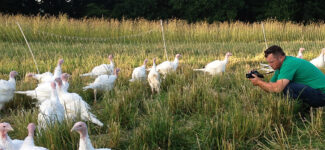No products in the cart.
Welcome to our website!
We're so happy you stopped by. Please let us know if you have any questions for us.

We're so happy you stopped by. Please let us know if you have any questions for us.
Don't forget to sign up for our mailing list to receive periodic emails about new products and upcoming events! You will also receive a Coupon Code for your first order.

Soil ecology is one of the most fascinating aspects of the pasture system. Although you wouldn’t guess it standing in a field and looking out over yards of waving grass, what you are seeing is only half the picture. There is a whole world under the grass which, just like Alice’s Looking-glass House, mirrors and mimics the other side.
Grass is symmetrical. The roots below the earth grow to the same length as the stalks above, so you know how much root mass you have based on what you see. When grass is grazed, the root mass dies back to mirror the new length. All of that root mass, though, is rich in plant nutrients, and when it dies, it feeds the plant and enriches the soil. This creates and deepens a lush topsoil, and also provides food for the grass and roots to grow again. If the grass is then grazed again, the roots die back again, more nutrients return to the soil, and additional rich soil is created. The grass and roots grow again, and the cycle continues.
This means that grazing is not just an animal feeding itself and taking from the earth, but an essential part of grass and soil husbandry. The very act of grazing is enriching and strengthening the soil.
Grazing, though, requires a proper cycle of disturbance and rest. Unless the grazing animals move to fresh pasture, the grass in a given area will never be given a chance to regrow, and the field’s fertility will become depleted. Thus migration is an essential component of grazing.
This is why the rotational method is so important—through rest and disturbance, it mimics the natural migratory nature of grassland animals. The result is good earth.
There are five main factors controlling animal health:
Although remedial treatment is needed when an animal becomes sick due to pathogens, animal health largely depends on healthy conditions and nutrition. Much of animal ill-health can be prevented by proper flock or herd density and proper diet.
Density is important to monitor. Not only does crowding increase animal frustration and harassment, but it also promotes pathogens. Ample space allows the animals freedom to exercise, to be curious and playful, to move around, including away from their own waste. We give our animals plenty of space, and move them frequently to fresh green pasture.
Diet is also very important. The animal’s nutritional needs must be met. Beyond that, though, if an animal is not matched to its natural food, problems arise. For example: cows stomachs are not designed to process corn in large amounts. It raises their acidity levels, which then increases their vulnerability to bacterial infections (such as E. coli). This also increases their risk for dehydration, gut damage, and liver problems. In your typical feedlot model, this is where the routine and systematic use of antibiotics enters. We are careful to match our animals to their natural diets: grass for cows, forest roots and forage for pigs, custom grains and grass for poultry. We also carefully monitor the nutritional intake of our animals so that we can supplement where necessary.
What are some of the natural supplements and methods we use to promote animal health and combat disease? One of them is oregano: we use it in our poultry feed to promote gut health. Oregano is antibacterial, antiviral, and anti-parasitic, and helps fight against bacterial outbreaks in the intestines.
We also use food grade diatomaceous earth (DE) in our chickens’ dust baths. Made from the fossilized remains of plankton, DE penetrates under the shells of mites and fleas and punctures their bodies. The bugs then dehydrate and die. DE is not a toxin (it kills insects physically) so there is no danger of pests’ developing an immunity to it. You can buy DE in any organic gardening store and use it for your own bug control.
The pasture setting and rest & rotational model in itself produces a healthier animal, eliminating the need for high-power drugs.
No products in the cart.
